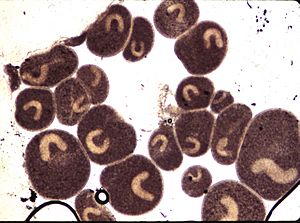Ichthyophthirius multifiliis facts for kids
Ichthyophthirius multifiliis, also called "white spot disease", "ick" or "ich" is a disease that causes little white spots on fresh water fish. It is one of the most common parasites of fish. It often affects pet fish in tanks and ponds, as well as farm-raised food fish species. Wild fish populations can also get the parasite.
Contents
Life cycle
The I. multifiliis life cycle from birth to death depends on the temperature of the water. In warm water, 25 °C (77 °F), the parasite's whole life cycle can take place in seven days. In cold water, 6 °C (43 °F), it can take up to eight weeks.
Disease
The disease starts when the parasite digs into the skin of the fish. This causes swelling and white spots to form. After a few days, the parasite turns into a trophozoite, a jelly-like substance. This falls off the fish and lives on the bottom of the tank. Inside the jelly are hundreds of baby parasites called tomites. These eventually can swim by themselves and go looking for another fish to live in.
Fish may have Ichthyophthirius multifiliis without there being anything to see. Fish owners need to be careful about where they get their fish from, as the disease can spread very easily. There are a number of different ways to try to get rid of the parasite. One method is to heat the water to kill the parasites in the water before they can infect the fish. Another method is to add salt to the water, or put the fish into a salt water bath. The water should be changed frequently to remove the parasites. Chemicals are also available which will kill Ichthyophthirius multifiliis. All these treatments need to be carefully planned for the type of fish species.
Fish with the disease will:
- Stop eating and lose weight
- Breathe quickly
- Hide
- Rest on the bottom of the tank
- Rub and scratch against objects
Images for kids
See also
 In Spanish: Ichthyophthirius multifiliis para niños
In Spanish: Ichthyophthirius multifiliis para niños




